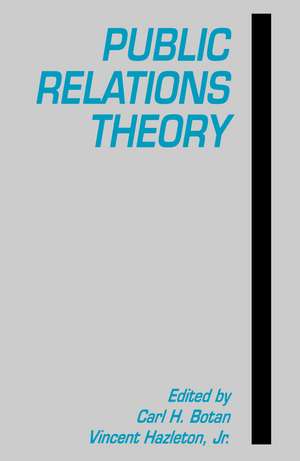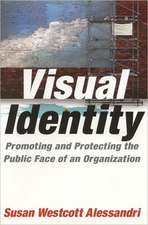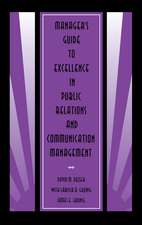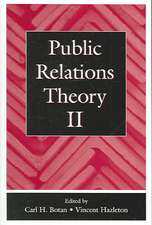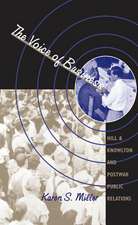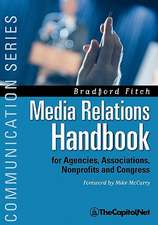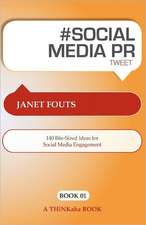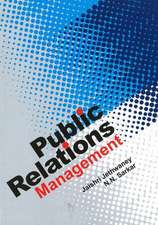Public Relations Theory
Editat de Carl H. Botanen Limba Engleză Paperback – sep 1989
Preț: 490.25 lei
Nou
Puncte Express: 735
Preț estimativ în valută:
93.84€ • 98.59$ • 78.86£
93.84€ • 98.59$ • 78.86£
Carte tipărită la comandă
Livrare economică 12-26 martie
Preluare comenzi: 021 569.72.76
Specificații
ISBN-13: 9780805806922
ISBN-10: 080580692X
Pagini: 368
Dimensiuni: 152 x 229 x 22 mm
Greutate: 0.48 kg
Ediția:1
Editura: Taylor & Francis
Colecția Routledge
Locul publicării:Oxford, United Kingdom
ISBN-10: 080580692X
Pagini: 368
Dimensiuni: 152 x 229 x 22 mm
Greutate: 0.48 kg
Ediția:1
Editura: Taylor & Francis
Colecția Routledge
Locul publicării:Oxford, United Kingdom
Recenzii
"...a significant attempt to develop a body of knowledge in the field. It is the first volume published specifically in public relations theory and therefore breaks new ground in the field's literature....should provoke thought, discussion, and research..."
—Southern Communication Journal
"...offers a bounty of material for scholarly reading and graduate classrooms. And practitioners would be well advised to inform their managerial and ethical decisions with ideas from the sections of metatheory and theory....The book should be read by all teachers and scholars in public relations and should be perused, at the very least, by those wanting to know what research and practice of public relations is all about. "
—Journalism Quarterly
—Southern Communication Journal
"...offers a bounty of material for scholarly reading and graduate classrooms. And practitioners would be well advised to inform their managerial and ethical decisions with ideas from the sections of metatheory and theory....The book should be read by all teachers and scholars in public relations and should be perused, at the very least, by those wanting to know what research and practice of public relations is all about. "
—Journalism Quarterly
Cuprins
Part I: Issues of Metatheory. V. Hazleton, Jr., C.H. Botan, The Role of Theory in Public Relations. J.E. Grunig, Symmetrical Presuppositions as a Framework for Public Relations Theory. G.R. Miller, Persuasion and Public Relations: Two Ps in a Pod. M. Prior-Miller, Four Major Social Scientific Theories and Their Value to the Public Relations Researcher. M. Smilowitz, R. Pearson, Traditional, Enlightened, and Interpretive Perspectives on Corporate Annual Reporting. C.H. Botan, Theory Development in Public Relations. R. Pearson, Business Ethics as Communication Ethics: Public Relations Practice and the Idea of Dialogue. Part II: Issues of Theory. G. Cheney, G.N. Dionisopoulos, Public Relations? No, Relations with Publics: A Rhetorical-Organizational Approach to Contemporary Corporate Communications. B.D. Neff, The Emerging Theoretical Perspective in PR: An Opportunity for Communication Departments. P. Murphy, Game Theory as a Paradigm for the Public Relations Process. J.K. VanLeuven, Theoretical Models for Public Relations Campaigns. J.C. Scott, III, D. O'Hair, Expanding Psychographic Concepts in Public Relations: The Composite Audience Profile. C.G. Cline, M.H. McBride, R.E. Miller, The Theory of Psychological Type Congruence in Public Relations and Persuasion. Part III: Issues of Application. D.J. Johnson, The Coorientation Model and Consultant Roles. G.L. Kreps, Reflexivity and Internal Public Relations: The Role of Information in Directing Organizational Development. K.E. Terry, Educator and Practitioner Differences on the Role of Theory in Public Relations. J.L. Guadino, J. Fritch, B. Haynes, If You Knew What I Knew, You'd Make the Same Decision: A Common Misperception Underlying Public Relations Campaigns? R.B. Anderson, Reassessing the Odds Against Finding Meaningful Behavioral Change in Mass Media Health Promotion Campaigns. P.K. Hamilton, Application of a Generalized Persuasion Model to Public Relations Research.
